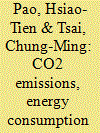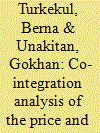|
|
|
Sort Order |
|
|
|
Items / Page
|
|
|
|
|
|
|
| Srl | Item |
| 1 |
ID:
101505


|
|
|
|
|
| Publication |
2010.
|
| Summary/Abstract |
This paper examines dynamic causal relationships between pollutant emissions, energy consumption and output for a panel of BRIC countries over the period 1971-2005, except for Russia (1990-2005). In long-run equilibrium energy consumption has a positive and statistically significant impact on emissions, while real output exhibits the inverted U-shape pattern associated with the Environmental Kuznets Curve (EKC) hypothesis with the threshold income of 5.393 (in logarithms). In the short term, changes in emissions are driven mostly by the error correction term and short term energy consumption shocks, as opposed to short term output shocks for each country. Short-term deviations from the long term equilibrium take from 0.770 years (Russia) to 5.848 years (Brazil) to correct. The panel causality results indicate there are energy consumption-emissions bidirectional strong causality and energy consumption-output bidirectional long-run causality, along with unidirectional both strong and short-run causalities from emissions and energy consumption, respectively, to output. Overall, in order to reduce emissions and not to adversely affect economic growth, increasing both energy supply investment and energy efficiency, and stepping up energy conservation policies to reduce unnecessary wastage of energy can be initiated for energy-dependent BRIC countries.
|
|
|
|
|
|
|
|
|
|
|
|
|
|
|
|
| 2 |
ID:
104899


|
|
|
|
|
| Publication |
2011.
|
| Summary/Abstract |
Agriculture has an important role in every country's development. Particularly, the contribution of agriculture to development and competitiveness is increasing with agricultural productivity growth. Productivity, in turn, is closely associated with direct and indirect use of energy as an input. Therefore, the importance of energy in agriculture cannot be denied as one of the basic inputs to the economic growth process. Following the importance of energy in Turkish agriculture, this study aims to estimate the long- and short-run relationship of energy consumption, agricultural GDP, and energy prices via co-integration and error correction (ECM) analysis. Annual data from 1970 to 2008 for diesel and electricity consumptions are utilized to estimate long-run and short-run elasticities. According to ECM analysis, for the diesel demand model, the long-run income and price elasticities were calculated as 1.47 and -0.38, respectively. For the electricity demand model, income and price elasticities were calculated at 0.19 and -0.72, respectively, in the long run. Briefly, in Turkey, support for energy use in agriculture should be continued in order to ensure sustainability in agriculture, increase competitiveness in international markets, and balance farmers' income.
|
|
|
|
|
|
|
|
|
|
|
|
|
|
|
|
| 3 |
ID:
126549


|
|
|
|
|
| Publication |
2013.
|
| Summary/Abstract |
Using cointegration techniques, we investigate the determinants of gasoline demand in Switzerland over the period 1970-2008. We obtain a very weak price elasticity of -0.09 in the short run and -0.34 in the long run. For fuel demand, i.e. gasoline plus diesel, the corresponding price elasticities are -0.08 and -0.27. Our rich dataset allows working with quarterly data and with more explicative variables than usual in this literature. In addition to the traditional price and income variables, we account for variables like vehicle stocks, fuel prices in neighbouring countries, oil shocks and fuel taxes. All of these additional variables are found to be significant determinants of demand.
|
|
|
|
|
|
|
|
|
|
|
|
|
|
|
|
| 4 |
ID:
103944


|
|
|
|
|
| Publication |
2011.
|
| Summary/Abstract |
This article investigates the exchange rate pass-through for Indian export and import prices. A markup model for aggregate export/import prices is set up, and the analysis is carried out using Johansen-Juselius cointegration and error correction models. The evidence shows partial pass-through into export prices, but more than complete pass-through into import prices, with the long-run pass-through coefficients being larger than the short-run coefficients. Thus, the Indian exporter does appear to have a little bargaining power, but it is not so with the Indian importer. The results cast a question mark over the efficacy of exchange rate changes as a policy tool in correcting trade balances, and also point to the risk of imported inflation.
|
|
|
|
|
|
|
|
|
|
|
|
|
|
|
|
| 5 |
ID:
118841


|
|
|
|
|
| Publication |
2013.
|
| Summary/Abstract |
Pakistan is facing severe electricity shortfall of its history since 2006. Several measures have been implemented in order to mitigate electricity shortage. The focus has been on raising the installed capacity of electricity generation and transmission. The present policy results in expensive thermal electricity generation mostly using expensive and environmentally hazardous furnace oil and inability of utilities to recover their cost of supply although there is unprecedented rise in electricity tariffs. This study concentrates on the electricity demand and traces the relationship between electricity shortfalls, tariff rate and electricity theft in the background of recent electricity crisis using the data for the period 1985-2010. We employed the Granger causality test through error correction model and out-of-sample causality through variance decomposition method. Empirical evidence shows that electricity theft greatly influences electricity shortfalls through lowering investment and inefficient use of electricity.
The study concludes that electricity crisis cannot be handled without combating rampant electricity theft in the country.
|
|
|
|
|
|
|
|
|
|
|
|
|
|
|
|
| 6 |
ID:
099779


|
|
|
|
|
| Publication |
2010.
|
| Summary/Abstract |
This paper investigates a contemporary issue of Macau concerning the impact of casinos on other sectors' employment. The long-run and short-run effects are investigated using data-oriented econometric models. In the long-run, the casino boom leads to an employment expansion in other sectors. However, the effect is insignificant in the short-run. Simulations from a theoretical model disclose the pure crowding-out effect of the increased casino employment on other sectors with other things the same as the situation of 2003. During the period 2004-2008, the crowding-out effect is more serious on the non-casino service sector than on the industrial sector. Results from both types of models shed light on policy options
|
|
|
|
|
|
|
|
|
|
|
|
|
|
|
|
|
|
|
|
|